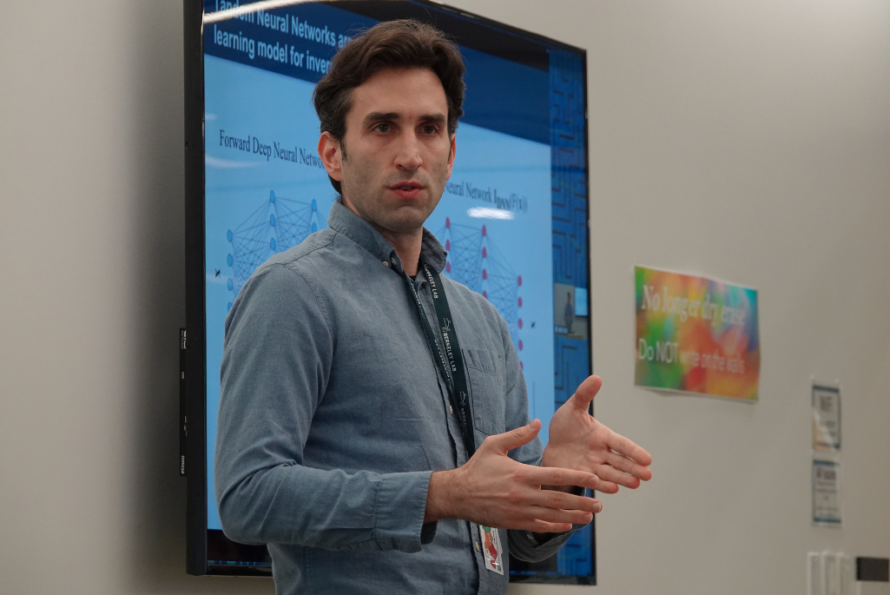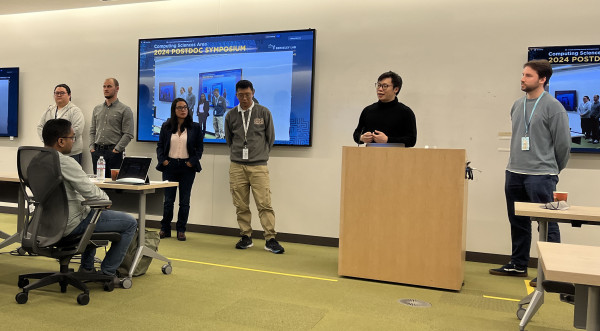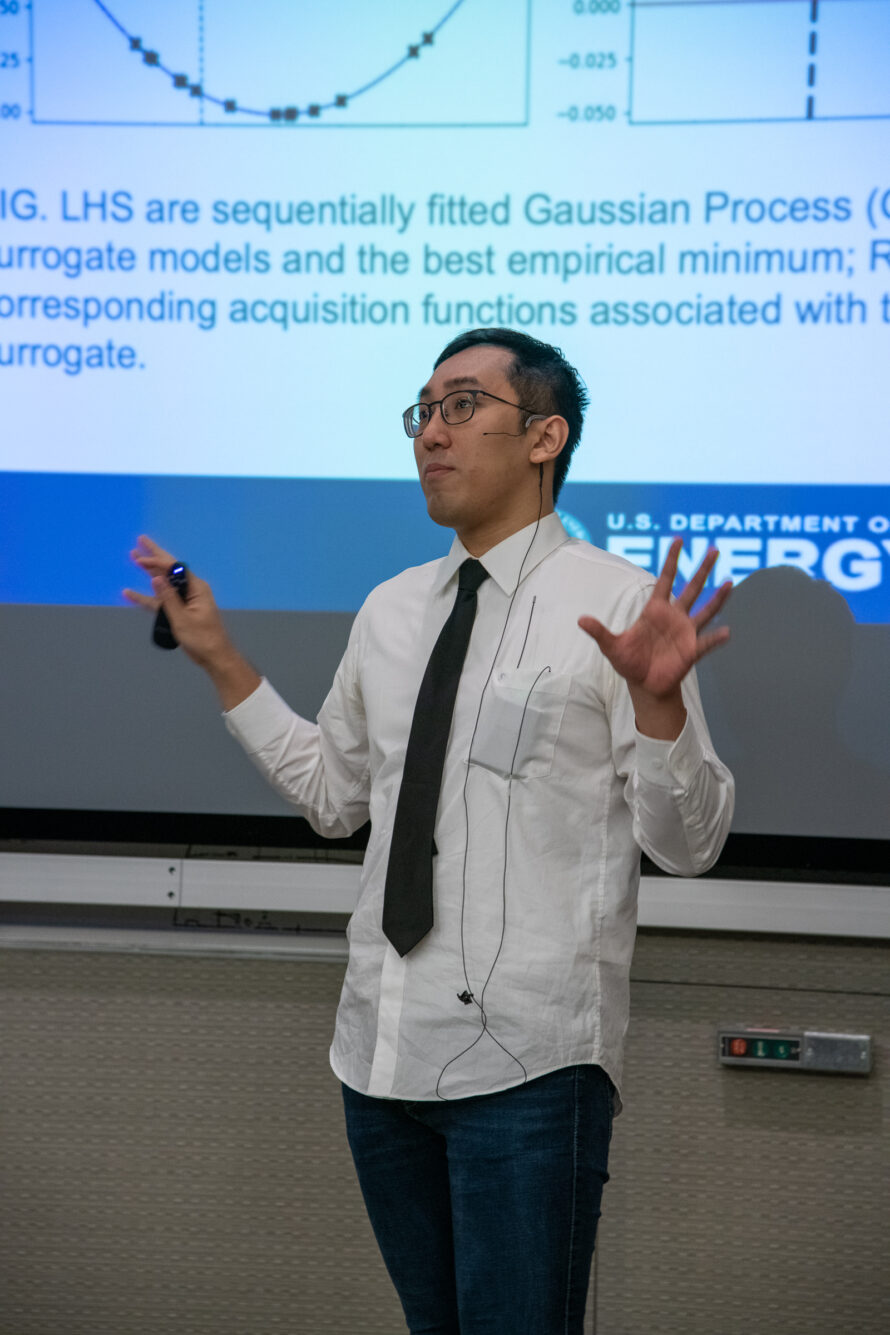
On Tuesday, Feb. 4, 2025, the CSA held its sixth annual Postdoc Symposium at Berkeley Lab, where 20 postdoctoral speakers currently working at the Lab shared 10-minute slide presentations on their exciting projects with an audience of peers, mentors, and coworkers. View their individual presentations below.
“Neutral Atom Entanglement with Adiabatic Rydberg Dressing”
Applied Computing for Scientific Discovery
Morning Session, Group 1
Abstract: Arrays of optically trapped neutral atoms are a promising candidate for scalable quantum computation. Entangling gates that generate entangled states from unentangled states are a key ingredient for quantum computation. High fidelity entangling gates for neutral atoms, mediated via highly excited Rydberg states, remain a challenge, despite significant recent progress. We present the neutral atom Mølmer-Sørensen gate involving rapid adiabatic Rydberg dressing interleaved in a spin-echo sequence. We show its robustness to quasi-static experimental imperfections and favorable scaling with the time-energy scales of Rydberg-mediated entanglement generation.
“Lie Algebraic Methods for Efficient Quantum Simulation Via Quantum Computation”
Applied Computing for Scientific Discovery Group
Morning Session, Group 1
Abstract: Quantum computers are naturally fit to simulate many body systems such as fermion and spin models, which describe most materials to a great extent. However, the current quantum computers are noisy, which requires us to obtain the most efficient quantum circuit for a desired unitary operation. This efficient compilation problem can be considered as a decomposition of a given unitary matrix into smaller or simpler unitary matrices, which is inherently a Lie algebra problem. This talk is about such methods that use both global and local Lie algebraic relations to obtain efficient quantum circuits for many body simulation.
“Sharp Interface Simulation of Ternary Alloy Solidification”
Applied Numerical Algorithms Group
Morning Session, Group 1
Abstract: We introduce a novel approach for constructing high-order time-split methods for time-dependent PDEs, utilizing W-methods based on approx matrix factorization for enhanced efficiency. Additionally, we propose boundary correction techniques to mitigate order reduction caused by time-dependent Dirichlet boundary conditions. By using approx matrix factorization which avoid the solution of nonlinear equations and only require solution of linear systems with tri-diagonal matrices, these techniques can easily be used efficiently in GPUs. Numerical experiments demonstrate the effectiveness of both approaches in achieving high-order accuracy with improved computational efficiency.
“Nucleic Acid Analysis Via Tensor Networks and Random Matrices”
Mathematics Group
Morning Session, Group 1
“In-memory coupling of solvers for multiscale wind energy simulations”
NERSC
Morning Session, Group 1
Abstract: Wind farm simulations require data from mesoscale atmospheric simulations as initial and boundary conditions for the microscale turbine environments. A file-based coupling of mesoscale and microscale solvers is computationally inefficient and restricted in the amount of data that can be exchanged. I will present a runtime, or in-memory, coupling of the Energy Research and Forecasting (ERF) atmospheric flow solver with the AMR-Wind turbine flow solver. I will demonstrate a one-way coupling of ERF to AMR-Wind for a typical atmospheric boundary layer simulation, which also allows for different temporal and spatial resolutions at the interface and hence more efficient use of computational resources. Finally, I will present our progress on a two-way coupling, which enables the microscale solver to feed back high resolution data to the mesoscale model for simulating interactions between distant wind farms or studying their effect on the regional environment.
“GPU Accelerated Sparse Cholesky Factorization”
Applied Numerical Algorithms Group
Morning Session, Group 2
Abstract: The solution of sparse symmetric positive definite linear systems is an important computational kernel in scientific computing. We will solve the linear systems using a direct method, in which a Cholesky factorization of the coefficient matrix is performed and the resulting triangular factors are used to compute the solution. Sparse Cholesky factorization is compute intensive. In this work we investigate techniques for reducing the factorization time in sparse Cholesky factorization by offloading some of the dense matrix operations on a GPU. We will describe the techniques we have considered. We achieved up to 4x speedup compared to the CPU-only version.
“Parallel Methods for Local Perturbation Theory in Correlation Energy Computation”
Scalable Solvers Group
Morning Session, Group 2
Abstract: The tensor-train (TT) format is a low rank tensor representation frequently used for high order tensors. Traditionally, the TT format is computed directly with all the elements in the tensor. In this talk, we propose a parallel algorithm framework that partition the tensor into subtensors and perform decomposition individually before merging back together. This type of factorization routine is ideal for distributed memory parallelism, and we have developed a couple of algorithms suitable for this framework. In particular, we focus on subtensor TT cross, a data-centric iterative method for data parallel TT decomposition. We provide theoretical guarantees, and scaling and communication analysis. Strong scaling results on synthetic and real-world datasets suggest that this algorithm scales well with the number of computing cores, with respect to both storage and timing.
“BULKI: Binary Unified Layout for Key-Value Interchange”
Scientific Data Management Group
Morning Session, Group 2
Abstract: BULKI is designed to address the limitations of traditional key-value formats in handling large-scale metadata operations efficiently. BULKI is designed to be a self-describing, multi-key structure that can be serialized and deserialized efficiently. Our vision is to cre- ate a compact and flexible format that facilitates high-throughput, metadata-driven applications.
“DISTRI: Development and Integration of Simulation Tools for Resilient Infrastructure”
Scientific Data Management Group
Morning Session, Group 2
Abstract: DISTRI is a flexible simulation framework designed to address the complexities of distributed, multi-facility workflows in scientific research. It enables customizable facility configurations, supports resilient scheduling and resource management, and provides detailed network simulation for efficient data communication. With features like agent-based distributed scheduling and comprehensive performance metrics logging, DISTRI facilitates in-depth analysis and optimization of large-scale, multi-facility environments. This framework enhances the study of resilience and efficiency in distributed systems, filling a critical gap in existing simulators for complex, multi-facility research workflows.
“Introduction to Wavelets”
Scalable Solvers Group
Morning Session, Group 2
Abstract: Wavelet series are collections of localized oscillatory functions, and have been used to represent complex data, and are widely used in fields like signal processing. Some series form a multiresolution analysis, in which the wavelets and their complementary functions construct the analogous functions at a finer resolution. This talk will introduce wavelet-based multi-resolution bases and discuss recent works using them for time integration of partial differential equations.
“AutoTandemML: Active Learning Enhanced Tandem Neural Networks for Inverse Design Problems”
Applied Computing for Scientific Discovery Group
Morning Session, Group 3
Abstract: We introduce an enhanced tandem neural network framework augmented with active learning strategies to address inverse design problems effectively. By integrating active learning, we selectively sample the most informative data points, improving learning efficiency of the Tandem Neural Network. This approach enables the model to more accurately map desired outputs to optimal input parameters. Numerical experiments demonstrate that our active learning-enhanced tandem neural network outperforms traditional methods in terms of solution accuracy across various inverse design applications in science and engineering. This work showcases the potential of combining active learning with neural networks to advance inverse design methodologies.
“Advanced Correlation Analysis Reveals the Rotational Diffusion from X-Ray Photon Correlation Spectroscopy Data”
Math for Experimental Data Analysis (MEDA) Group
Morning Session, Group 3
“Interpolation-Based Trust-Region Methods for Black-Box Optimization”
Math for Experimental Data Analysis (MEDA) Group
Morning Session, Group 3
Abstract: This talk will discuss the interpolation-based derivative-free trust-region methods. I will show why and how interpolation is working for optimization in the case where no true derivative information is provided. Applications, history, recent progress, and potential future work will be included.
“Spectral Estimation via Signal Subspace Expansion with Real-time Evolution”
Scalable Solvers Group
Morning Session, Group 3
Abstract: Quantum algorithms exploiting real-time evolution under a target Hamiltonian have demonstrated remarkable efficiency in extracting key spectral information. However, the broader potential of these methods, particularly beyond ground state calculations, is underexplored. Here we introduce the framework of multi-observable dynamic mode decomposition (MODMD), which leverages random scrambling to construct, with exponentially reduced resource, a signal subspace encoding rich spectral information. To demonstrate the utility of our framework, we consider application to fundamental tasks such as determining the low-lying energies of many-body systems. This work paves the path for efficient designs of measurement-driven algorithms on near-term and early fault-tolerant quantum devices.
“Understanding Principles of Brain Computations Using Feedback Control Theory”
Computational Biosciences Group
Morning Session, Group 3
“Multiscale Simulation Framework: Integrating Language-Interooperability & Machine Learning for Adaptive Closure Modeling”
Center for Computational Sciences and Engineering Group
Afternoon Session, Group 4
Abstract: Continuum modeling of complex fluid dynamics without known constitutive rheology is computationally challenging. Traditional methods using particle-based simulations for each fluid cell or precomputing the rheological space are often intractable due to the vast, unknown rheological spaces. This study employs ensemble deep learning to approximate the intrinsic rheology with quantified uncertainty, focusing on under-sampled, high-variance areas. This adaptive multiscale method reduces the need for extensive particle simulations, making the problem more tractable. Demonstrated on granular materials and suspensions, the approach accurately predicts macroscopic dynamics influenced by particle properties, validated against particle-resolved methods like the discrete element method.
“A Multimodal Framework for Material Discovery: Infusing Large Language Models with Atomic Structures”
Center for Computational Sciences and Engineering Group
Afternoon Session, Group 4
Abstract: We introduce a multimodal framework that aligns a pretrained foundation graph neural network with a pretrained large language model, designed to address complex challenges in materials science. Our approach leverages a bridge model that not only aligns text-based information with structural insights but also enriches the model’s interpretability and depth. Through multimodal retrieval-augmented generation, this framework improves task processing and significantly enhances performance in materials science question-answering (QA) tasks. Our results show that this approach consistently outperforms existing models across a range of material property prediction tasks.
“Time-Series in the Age of Transformers: Enforcing Causality and Locality”
Mathematics Group
Afternoon Session, Group 4
Abstract: Transformers produce state-of-the-art results on time-series data, but it is still an open question whether their all-to-all attention mechanism applies to casual datasets. The causal nature of time-series data precludes a measurement from being dependent on a future one. Moreover, in many natural phenomena the pairwise correlation decays according to a power law as the time between points grows. We introduce Powerformer, a Transformer-based model with a novel causal implicit bias to improve forecasting performance. Powerformer eliminates noncausal attention weights and reweights causal weights to be consistent with power law decays. Powerformer outperforms other Transformers on various time-series forecasting tasks.
“Learning from Mistakes with Adaptive Quotient Filters”
Performance and Algorithms Group
Afternoon Session, Group 4




